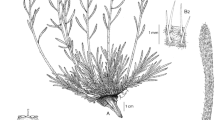Abstract
A new species, Goodyera crassifolia (Orchidaceae: Orchidoideae; Cranichideae), distributed on offshore islands in southwestern Korea and in Japan, is described and illustrated. It is a terrestrial orchid characterized by having thick and fleshy leaves with pale green markings on the midrib and mottled with pale green markings on the lateral veins of the adaxial surface, erect and weakly oblique lateral sepals, lateral column appendages, and one-to-three rostella. Plants of G. crassifolia have been misidentified as G. schlechtendaliana. The two species often co-occur, but G. schlechtendaliana blooms earlier than G. crassifolia, showing a gap in their flowering times. Plants of G. schlechtendaliana flower from late August to early September, whereas those of G. crassifolia bloom from late September to early October. The chromosome number of G. crassifolia is 2n = 60, twice as many as the chromosome number of G. schlechtendaliana.





Similar content being viewed by others
References
Bhattacharjee A, Chowdhery HJ (2012) Notes on two species of Goodyera (Orchidaceae). Kew Bull 67:503–510
Chen XQ, Lang KY, Gale SW, Cribb PJ, Ormerod P (2009) Goodyera. In ZY. Wu, PH Raven, DY Hong, eds. Flora of China, vol 25, Orchidaceae, Beijing and St. Louis: Science Press and Missouri Botanical Garden, pp. 45–54
Dressler RL (1993) Phylogeny and Classification of the Orchid Family. Dioscorides Press, Portland
Felix LP, Guerra M (2005) Basic chromosome numbers of terrestrial orchids. Pl Syst Evol 254:131–148
Hu C, Tian HZ, Li HQ, Hu AQ, Xing FW, Bhattacharjee A, Hsu TC, Kumar P, Chung SW (2016) Phylogenetic analysis of a ‘Jewel Orchid’ genus Goodyera (Orchidaceae) based on DNA sequence data from nuclear and plastid regions. PLoS ONE 11:e0150366
IUCN. 2019. Guidelines for using the IUCN red list categories and criteria, version 14. Gland, Switzerland and Cambridge, UK: IUCN. https://www.iucnredlist.org/resources/redlistguidelines (accessed 30 July 2020)
Jang YJ, Park JS, Lee JS, Lee JY, Choi BH (2021) Re-examination of the vascular plants on Hongdo Island, Korea. Korean J Pl Taxon 51:205–249
Juswara LS, Ormerod P (2016) Revision of Goodyera rubicunda (Orchidaceae: Goodyerinae). Telopea 19:113–124
Kallunki JA (2002) Goodyera. In Flora of North America editorial committee, ed. Flora of North America north of Mexico, vol 26, Magnoliophyta: Lilidae: Liliales and Orchidales. Oxford University Press, New York, pp. 514–517
Kurzweil H (1987) Developmental studies in orchid flowers II: Orchidoid species. Nordic J Bot 7:443–451
Kurzweil H (1990) Floral morphology and ontogeny in Orchidaceae subtribe Disinae. Bot J Linn Soc 102:61–83
Lee NS (2011) Illustrated flora of Korean Orchids. Ewha Womans University Press, Seoul (in Korean)
Lee CS, Yeau SH, Lee KS, Lee NS (2010) A new taxon of Goodyera (Orchidaceae): G. ×tamnaensis. Korean J Pl Taxon 40:251–254
Lee CS, Kim SC, Yeau SH, Lee NS (2012) Nuclear and cpDNA sequences demonstrate spontaneous hybridization between Goodyera schlechtendaliana Rchb. f. and G. velutina maxim. (Orchidaceae) in Jeju Island. Korea Syst Bot 37:356–364
Maekawa F (1971) The wild orchids of Japan in Colour. Seibundo-Shinkosa, Tokyo
Ohwi J (1965) Flora of Japan. Smithsonian Institution, Washington, D.C.
Pridgeon AM, Cribb PJ, Chase MW, Rasmussen FN (2003) Genera Orchidacearum, vol 3. Oxford University Press, New York
Serizawa S (2008) Tokaichihono-yusuishicchini-seiikusuru-rankanoichishinshu, ‘Oh-miyamauzura.’ Proceedings of the 7th Annual Meeting of the Japanese Society for Plant Systematics: 83. (In Japanese)
So JH, Lee NS (2016) The origin of new natural hybrid, Goodyera ×maximo-velutina (Orchidaceae) from Jeju Island, Korea. Phytotaxa 317:61–68
So HJ (1978) Orchidaceae. In Flora of Taiwan editorial committee, ed. Flora of Taiwan. Epoch Publishing Co., Taipei, 859 1137
Sun BY, Park JH, Kwak MJ, Kim CH, Kim KS (1996) Chromosome counts from the flora of Korea with emphasis on Apiaceae. J Plant Biol 39:15–22
Tae KH, Lee EH, Ko SC (1997) A systematic study of the genus Goodyera in Korea by morphological and cytological characters. Korean J Plant Taxon 27:89–116 (in Korean)
Takahashi K (1985) Yaseiran-omoshiro-koza. Mainichishinbun-sha, Tokyo
Thiers B (2018) [continuously updated] Index Herbariorum: A global directory of public herbaria and associated staff. New York Botanical Garden's Virtual Herbarium. Available from: http://sweetgum.nybg.org/science/ih/ (last accessed April 2022).
Yukawa T, Nakayama H, Takano M, Matsuoka H, Yamashita H (2015) The Handbook of Japanese Wild Orchids: Warm-termperate regions. Bun-ichi, Tokyo
Zhou S, Zhou XX, Jin Y, So JH, Lee NS, Schuiteman A, Kumar P, Tian HZ (2020) On the identity of Goodyera rosulacea (Orchidaceae: Orchidoideae: Cranichideae: Goodyerinae). Kew Bull 75:3
Acknowledgements
We thank Young-Il Lee, Jeong-Won Yeom, Sang-Wook Han, and Yun-Kyeong Choi for their help throughout the project. We also would like to thank Ryozo Fujii, Hiroshi Nakayama, and Koji Tanaka who kindly provided samples used in this study. We are grateful to the curators and staff of KB, KH, and TI for allowing us to examine their herbarium specimens. This work was supported by research grants from the National Research Foundation of Korea (NRF-2016R1D1A1B03934663, NRF-2020R1I1A3068464) to the first author.
Funding
The work of Sang-Hun Oh was supported by the National Research Foundation of Korea under Grants NRF-2016R1D1A1B03934663 and NRF-2020R1I1A3068464.
Author information
Authors and Affiliations
Contributions
All authors contributed to the field observations, morphological analysis of closely related species, and the writing and editing of the manuscript. SHO coordinated the project, generating the morphological analysis, description, illustration, and a draft of the manuscript. HJS provided the initial idea for the project, and was involved with the writing, illustrations, and photographs. SWS contributed writing and photographs, KSC conducted chromosome counts, and TY contributed writing and provided information about the Japanese populations. All authors agreed on the contents of the paper and claimed no conflicting interests.
Corresponding author
Rights and permissions
About this article
Cite this article
Oh, SH., Suh, HJ., Seo, SW. et al. A New Species of Goodyera (Orchidaceae: Orchidoideae) from Korea and Japan. J. Plant Biol. 65, 357–363 (2022). https://doi.org/10.1007/s12374-022-09358-1
Received:
Revised:
Accepted:
Published:
Issue Date:
DOI: https://doi.org/10.1007/s12374-022-09358-1




